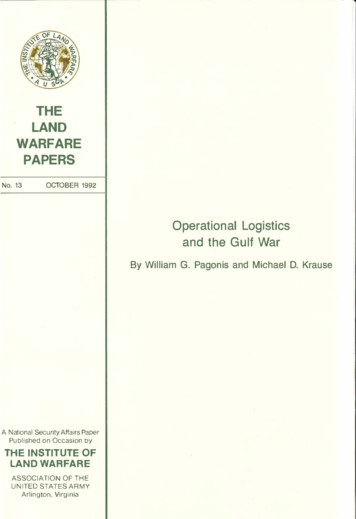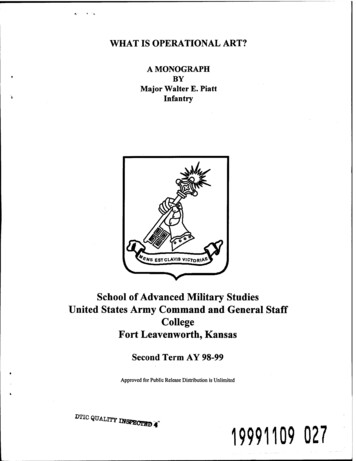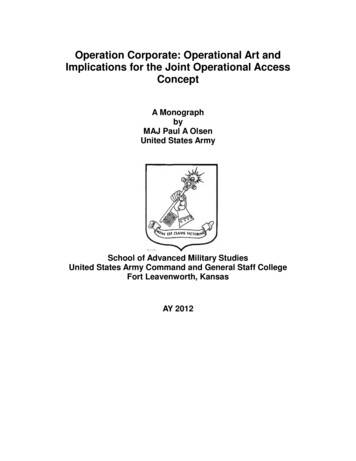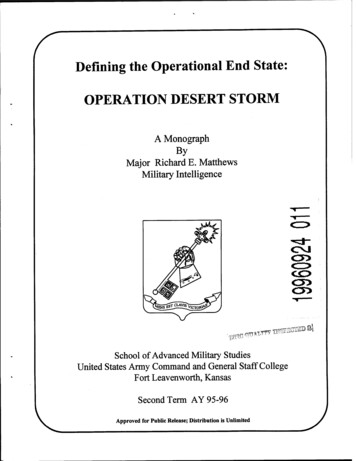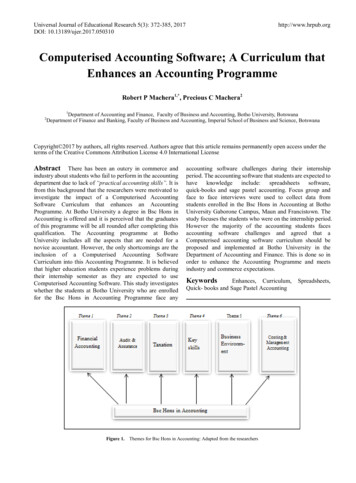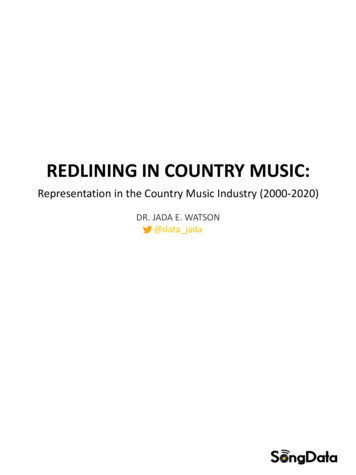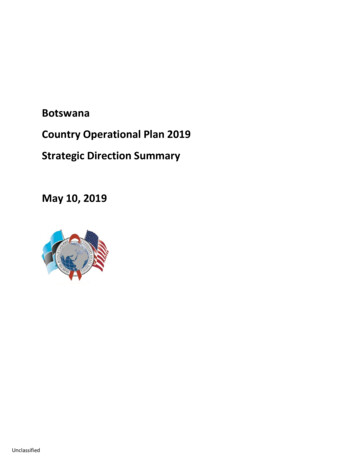
Transcription
BotswanaCountry Operational Plan 2019Strategic Direction SummaryMay 10, 2019Unclassified
Table of Contents1.0 Goal Statement . 32.0 Epidemic, Response, and Program Context Statement . 52.1 Summary statistics, disease burden and country profile . 52.2Investment Profile . 152.3 National Sustainability Profile Update . 202.5 Stakeholder Engagement . 243.0 Geographic and Population Prioritization . 264.0 COP19 Reboot Program Activities and MPR Implementation in Priority Locations . 294.1 Overview of PEPFAR Botswana Reboot . 294.2 Additional country-specific priorities listed in the planning level letter . 564.3 Supply Chain . 614.4 Commodities . 634.5 Collaboration, Integration and Monitoring . 644.6 Targets for scale-up locations . 715.0 Prevention Support Necessary to Achieve Sustained Epidemic Control . 745.1PMTCT . 745.2OVC . 755.3 DREAMS . 795.4KEY POPULATIONS . 835.5 Voluntary Medical Male Circumcision (VMMC) . 865.6Cervical Cancer Prevention Program . 876.0 Program Support Necessary to Achieve Sustained Epidemic Control. 896.1Health Information System Strengthening (Reference Appendix C) . 896.2 Free HIV Treatment for non-citizens . 907.0 Staffing Plan . 91APPENDIX A -- Prioritization . 93APPENDIX B – Budget Profile and Resource Projections . 95APPENDIX C – Table for Section 6 . Error! Bookmark not defined.APPENDIX D – Minimum Program Requirements . 97APPENDIX E – Addressing Gaps to Epidemic Control including through Communities of Faith . 102APPENDIX F – Acronym List . 106APPENDIX G – PEPFAR Botswana Partners and Stakeholders . 1112 PageUnclassified
1.0 Goal StatementBotswana, once a world leader in the response to HIV, now faces unique structural impediments to itsprogress in reaching HIV epidemic control. Formal and informal policies hinder efforts to diagnose andimmediately treat people living with HIV. Although immediate and universal ART provision has beenadopted in Botswana, providers and clients remain reluctant to embrace same-day linkage to treatmentefforts, and some populations are still left behind. Access to free government treatment remainsunavailable to the estimated 30,000 people living with HIV in Botswana who are non-citizens. Currentprograms have also seemingly left men behind – there are an estimated 20,000 HIV-positive men who areundiagnosed, and another 50,000 who are either not virally suppressed or who know their status but arenot on ART. Evidence suggests a need for a major shift in the current policy environment and programimplementation in order for Botswana to realize its potential for stemming the national HIV epidemic.The goal of COP19 is to work as “one Botswana” with all stakeholders to eliminate policy barriers and refocus strategies on delivering innovative, client-centered programs in order to reach the 95-95-95 goalsacross all sex and age bands. The Government of Botswana has realized the need to do things differentlyand has recently adopted the recommended Minimum Program Requirements (MPRs). Among the MPRsthat will help revitalize the response to HIV at the ground level are the offer of same-day and fast trackART initiation to all newly diagnosed patients; adoption of differentiated service delivery models,including three months of ART delivery (MMD) for stable patients; better screening and more effectivecase identification strategies, including scale-up of self-testing and index testing with active partnernotification; the re-introduction of TB Preventative Therapy (TPT) across the country; the transition to TLDand removal of Nevarapine-based drug regimens; and improving patient-level data collection andintegration of data systems. The Minister of Health and Wellness has assured the U.S. Ambassador thathis ministry is taking seriously its commitment to implement all MPRs, and he has raised the issue ofproviding free HIV treatment to non-citizens to Botswana’s Cabinet for approval. The Office of the GlobalAIDS Coordinator (S/GAC) has approved conditional catalytic funding to MoHW to support treatment fornon-citizens following Parliament’s approval of the policy change and pledge of future budget support.In COP19, PEPFAR/B will support the GoB to ensure implementation of the MPRs with fidelity at alldistricts and sites while building on new data available to adjust approaches and address key barriers. Asite realignment focused on 71 high volume facilities, and several key population hotspots, is intended toenable PEPFAR and the GoB to demonstrate the impact of fully implementing the MPRs nationwide withfidelity in the highest disease burdened areas. Earlier this year, Botswana launched the Botswana AIDSImpact and TB Prevalence Survey (BAIS V) with results expected at the end of 2019. COP19’s realignmentto a national direct support program to achieve policy implementation and ensure quality HIV servicedelivery should position Botswana to move quickly towards 95-95-95 once BAIS V data becomes available.Meanwhile, programming to reach key populations is being improved with data from the secondBotswana Behavioral and Biological Surveillance Survey (BBSS 2017) which provided updated KPpopulation estimates and highlighted some successes of the PEPFAR-supported KP program to date, suchas a decrease in prevalence for female sex workers from 61.9% to 42.8% between 2012 and 2017.3 PageUnclassified
COP19 will also replicate at scale relevant lessons learned from “reboot” of COP18 implementation.Botswana has embraced the term reboot, which can mean to start anew or transform, by bringingHIV/AIDS providers and service delivery stakeholders onboard to ensure every HIV-diagnosed individualis immediately linked to treatment, retained in care and remains virally suppressed. Focus at the groundlevel will include improvements in:oOptimization of HIV Case Identification: This includes improved screening techniques, offeringservices at multiple service points and, where feasible, after hours and on weekends. Evidencehas shown higher yields among men during extended hours.oSame-Day and Fast-Track Initiation of ART: Clients who test HIV positive will be escorted to anurse prescriber or physician for same-day ART initiation. In cases where initiation within threedays is not possible, facilities will refer clients to community partners to ensure ART initiationoccurs within one week of diagnosis.oOptimization of Viral Load Access: All government and private practices must devise systems forensuring each and every client on ART receives at least one viral load test per year, and receivesthose results. Providers must track clients who miss their viral load appointments or results intheir medical files and ensure they are linked back to receive them. Tracking efforts will includeengaging community partners to ensure clients are linked for viral load.oPatient Retention in Treatment: All HIV service providers must devise strategies for retainingclients on ART, creating and instituting systems for monitoring missed appointments and takingaction before clients get lost to care. Providers track defaulters and devise case-managementplans to bring them back into treatment. Defaulters are referred to community partners for followup and re-initiation.oM&E: Reporting results of case identification, ART initiation, retention and viral load tests inelectronic patient management systems is just as important to the success of the nationalresponse as the work itself. Without good data in electronic systems and shared in the nationaldata warehouse, Botswana cannot reliably show success at attaining the 95-95-95 goals.Reboot activities have been taking place with great success since February 2019 at 41 high-volumegovernment facilities, two non-governmental wellness clinics and surrounding communities and five KPhotspots. In these places, case identification and yield has improved, linkage-to-treatment rates areincreasing, and retention and viral load coverage is greatly improved. In COP19, it is expected that DHMTstake the coordinating role for Reboot activities in their respective districts, working closely with PEPFAR,implementing partners and all district stakeholders to identify challenges and come up with district andsite-specific solutions.PEPFAR/B will continue prevention efforts through the VMMC, OVC, Cervical Cancer and DREAMSprograms. VMMC will strive to close the unmet need following the gap analysis conducted in COP18 withthe MoHW. The OVC will increase its focus on the 9-14 year olds girls and boys working through schoolsto provide primary prevention of sexual violence and HIV and other socio-economic interventions.4 PageUnclassified
Through DREAMS, PEPFAR/B is offering a package of evidence based combination preventioninterventions that target vulnerable adolescent girls and young women (AGYW), their families,communities and sex partners with the ultimate goal of protecting the AGYW from HIV infection. InCOP19, PEPFAR/B will continue to build on the existing platform and strategies to increase cervical cancerscreening among Women Living with HIV (WLHIV) aged 25-49 on ART.COP19 will require a coordinated effort from all stakeholders. Failure to address barriers could mean thefurther loss of international funding for Botswana. But worse than that, failure would mean fewer peopleon treatment and virally suppressed, and consequently more new infections and lost lives. Botswanashould be, as it once was, a world leader in the response to HIV. COP19 is the opportunity for the countryto return to the front of the race for an AIDS-free generation.2.0 Epidemic, Response, and Program Context Statement2.1 Summary statistics, disease burden and country profileBotswana is a sparsely populated land locked country with a population of approximately 2.36 million(Census 2018 Projection). HIV infection in Botswana, one of the hardest hit countries in the world, islargely concentrated in the urban and peri-urban areas of the country with the highest disease burdensin Greater Gaborone and Greater Francistown. The burden in absolute numbers is highest among olderpopulations (age 25 ), and strikingly so among women. Botswana’s 2017 GNI per capita, according toWorld Bank, was 6,730. While classified as an upper middle-income country, its Gini index was 53.3(World Bank, 2015), reflecting one of the starkest income disparities globally.The most recent Botswana prevalence survey was conducted in 2013. However, in April 2019, Botswanalaunched the Botswana AIDS Impact (BAIS V) and TB Prevalence Survey. Until the preliminary results areshared and the final report, expected at the end of 2019, PEPFAR/B will continue to use program data andUNAIDS Spectrum estimates to guide program decisions. The most recent UNAIDS Spectrum (2018)estimates suggest a lower burden of HIV compared to the previous year, although modifications to themodel may account for the apparent differences. The PLHIV estimate is now 369,707, which is a reductionby approximately 2.24% from the prior year’s Spectrum estimate of 378,184. The estimated incidencerate decreased from 0.58 last year to 0.44, and estimated new infections decreased from 13,797 to 8,517.UNAIDS’ estimates of Botswana’s HIV prevalence have decreased from 17% to 16%. Males age 15-24 andboth females and males older than 25 appear to have a lower estimated prevalence in the 2018 estimatescompared to the 2017 estimates. The number of pregnant women estimated to need ARV has increasedfrom 11,629 to 12,520 as the estimated population size and number of annual births have increased.Other areas of note comparing 2017 and 2018 include: Increase in AIDS-related deaths from 4,062 to 4,923 (highest in 25 males and females);Decrease in estimated AGYW population from 230,284 to 212,909.The second Botswana Behavioral and Biological Surveillance Survey (BBSS 2017), the first in five years, hasprovided data related to key populations (KP). The data analysis shows significant progress in reaching KP,especially female sex workers (FSWs). The results show a decrease in prevalence for FSW from 61.9% to5 PageUnclassified
42.8% (2012, BBSS; 2017 BBSS). For men who have sex with men (MSM) the trend was not the same, withprevalence increasing from 13.1% in 2012 to 14.8% in 2017. The report is important to understand theepidemic in KP and allows us to further focus our KP activities.Figure 2.1 and Table 2.1.1 reflect a national ART coverage estimate of 82%. Women age 25 have thehighest coverage at 94%; the lowest ART coverage is among males younger than 15 and males 15-24 years,47% and 53%, respectively. Botswana’s viral suppression rate overall is high at 85%, however youngerpeople have much lower rates, with the 15 years olds at 34%. The PEPFAR/B team used PEPFAR programdata and the Data Warehouse to evaluate testing yields and linkage to ART rates.Figure 2.1 Botswana: PLHIV Population PyramidIn FY18, approximately 403,657 people were tested, about 16,320 were identified as HIV positive and alittle more than 12,100 initiated ART. The overall testing yield was 4%, while the overall ART initiation ratewas 74.5%. These data are invaluable for assisting the national and PEPFAR programs in developingpopulation specific programming approaches.The Botswana PMTCT program continues to achieve high coverage of HIV testing and enrollment of HIVinfected pregnant women on life-long ART. National HIV testing uptake of 97% and treatment uptake of96.2% have resulted in a perinatal transmission rate of 0.7% in 2018 (national PMTCT program data).PEPFAR/B’s overall FY18 achievement for the percentage of pregnant women with known HIV status atantenatal care was 95.9% (22,999/23,992) and the overall achievement for PMTCT ART was 94.5%(5139/5440). In FY19 Q2, the achievement for women who knew their HIV status was 99.9% (6451/6460),an improvement from 99.7 % (5785/5802) in FY19 Q1 and the achievement of pregnant women whoregistered at Antenatal Care (ANC) who received lifelong ART in FY19 Q2 was 99.9% (1479/1480)compared to 99.8% in the FY19 Q1. Despite high coverage of HIV testing and enrolling HIV-infectedpregnant women on life-long ART, coverage for early infant diagnosis (EID) at 4-6 weeks remained low at56% according to 2018 national program data. This trend had never surpassed 50% since the inception ofthe EID program until FY17 data showed 60% EID coverage at two months and 88% at 12 months. EIDcontinues to be a major area of focus for PEPFAR/B in FY19 and FY20.6 PageUnclassified
Table 2.1.1Unclassified90-90-90 cascade: HIV diagnosis, treatment and viral suppression
Since inception of the national safe male circumcision (SMC) program, 225,732 voluntary medical malecircumcision (VMMC) procedures were performed in Botswana, representing approximately 35%coverage in the male populations aged 10 to 49 years. VMMC will continue to be a major area of focus forPEPFAR/B during COP 2019 implementation, as we strive to close the unmet need following the gapanalysis conducted with the MoHW in COP18.Botswana conducted the BBSS II (2017) among KP in five districts (Gaborone, Francistown, Chobe,Palapye, and Ngamiland South). Among FSW, 96% had been tested for HIV at some point in the past, andabout half were tested in the last year. Also, access to treatment for those FSW who knew their statusimproved drastically since 2012 – from 25% to 88%, and 99% report taking their ARVs every day. Theproportion of MSM who have ever tested has increased significantly since 2012 (76% vs. 92%) and thistrend is seen across districts. Testing rates are highest in Gaborone and Chobe and fairly similar inFrancistown, Palapye and Maun. Most have been tested in the last 12 months. In COP19, PEPFAR/B willcontinue to focus on keeping KP negative through prevention efforts that include PrEP, condoms andlubricants as well as addressing proximate determinants of HIV and STI infection, scaling up self-testingand index testing strategies and a continued increased focus on enhanced linkage to and retention in care.The key intervention area for the key population program in COP19 will target keeping the young keypopulation members negative through PrEP provision, and condom and lubricant distribution. Proximatedeterminants of HIV and STI infection will be addressed during the HIV prevention sessions. Additionally,the KP program will focus on scaling up self-testing and index testing strategies that use social networks,enhanced peer outreach approaches and social media approaches. For the second 90, PEPFAR/B will focuson enhancing our linkage to care and early initiation on ART using a differentiated model of services.Finally, for the third 90, PEPFAR/B will scale up with fidelity activities that retain those who are ontreatment, provide adherence support, and ensure that they are virally suppressed.The biggest development in COP19 is the recent adoption, by the GoB, of the WHO normative guidanceand PEPFAR Minimum Program Requirements (MPRs) and the development of a Botswana-specific MPRrelated to national data. These overarching MPRs encompass the critical elements necessary to achieveepidemic control, and have set the stage for how MoHW and PEPFAR/B will collaborate now and in thefuture.These 14 Minimum Requirements comprise of:Unclassified
2. Adoption and implementation of differentiated service delivery (DSD) models, including six monthmulti-month scripting (MMS) and delivery models to improve identification and ARV coverage ofmen and adolescents. The team should implement DSD approaches in all sites that include, by the end of theyear, a minimum of 6-month ART delivery for stable patients, as well as other strategiesto ensure ART coverage and utilization by men and persons 25 or younger.3. Completion of TLD transition, including consideration for women of childbearing potential andadolescents, and removal of Nevirapine based regimens. Botswana will exhaust the remaining TLE stock and complete its TLD transition in COP19.4. Scale up of index testing and self-testing, and enhanced pediatric and adolescent case finding,ensuring consent procedures and confidentiality are protected and monitoring of intimatepartner violence (IPV) is established. The team should work with key partners to advance policy shifts permitting index partnertesting with fidelity as defined by PEPFAR guidance and Solutions Platform resources.5. TB preventive treatment (TPT) for all PLHIVs must be scaled-up as an integral and routine part ofthe HIV clinical care package. The team must work with its GoB partners to expand eligibility for TPT beyond those forwhom it is approved ( 5 yr olds). TPT must become a routine part of clinical care.6. Direct and immediate ( 95%) linkage of clients from testing to treatment across age, sex, and riskgroups. Team should scale up same-day ART initiation. COP19 IP work plans need to be revisedaccordingly.7. Elimination of all formal and informal user fees in the public sector for access to all direct HIVservices and related services, such as ANC and TB services, affecting access to HIV testing andtreatment and prevention. No user fees are collected at public facilities for HIV and related services.8. Completion of VL/EID optimization activities and ongoing monitoring to ensure reductions inmorbidity and mortality across age, sex, and risk groups. Team must address and resolve policy barriers to achieve viral load monitoring for allpersons on ART.9. Monitoring and reporting of morbidity and mortality outcomes including infectious and noninfectious morbidity. Data systems must be updated to collect morbidity and mortality data (TX ML) andproviders should be trained to report it consistently.10. Alignment of OVC packages of services and enrollment to provide comprehensive prevention andtreatment services to OVC ages 0-17, with particular focus on adolescent girls in high HIV-burdenareas, 9-14 year-old girls and boys in regard to primary prevention of sexual violence and HIV, andchildren and adolescents living with HIV who require socioeconomic support, including integratedcase management. PEPFAR/B must update its data systems to track the layering of DREAMS services.11. Evidence of resource commitments by host governments with year after year increases.9 PageUnclassified
GoB remains the majority proportion of the national HIV response. However, it mustextend treatment access to non-citizens, who are estimated to account for 7% of PLHIVin Botswana.12. Clear evidence of agency progress toward local, indigenous partner prime funding. Each agency should work with their headquarters team to allocate at least 70% ofresources to local/indigenous partners in COP19 and work toward a timeline for progressin future FYs.13. Scale up of unique identifier for patients across all sites. PEPFAR/B should utilize its unique patient identifier to improve tracking of patients,particularly those who have fallen out of care, passed away, or relocated.14. Develop and implement an M&E strategy to track and improve performance across the healthsector. (A more detailed description of these 14 MPRs and how they are being addressed and supported can befound in section 4.3 and Appendix D)10 P a g eUnclassified
Table 2.1.2 Host Country Government ResultsUnclassified
12 P a g eUnclassified
Figure 2.1.313 P a g eUnclassifiedNational and PEPFAR Trend for Individuals currently on Treatment
Figure 2.1.4 Trend of New Infections and All-Cause Mortality among PLHIV14 P a g eUnclassified
2.2Investment ProfileA major constraint of the Botswana public health system is efficiency and effectiveness of spending, notavailability of funding. Botswana’s fiscal space is relatively unconstrained in absolute terms, in the shortterm, due to high fiscal revenues from diamond exports and a history of prudent public financialmanagement. Despite a positive outlook in the short-term, a steady, long-term contraction of fiscal spaceis taking place as the fiscal contribution of the highly-taxed diamond sector diminishes. In this context,the high level of public spending commitments, much of which involves very inefficient spendinggenerated on the basis of high historical revenues, has to be managed downwards while ensuring thatpublic resources are allocated as optimally as possible in improving social welfare. Major health financingreforms are needed to improve efficiency and address financial sustainability issues.Economic growth is volatile and still highly subject to the performance of the diamond sector, which inrelative terms is in long-term decline. Although renowned as one of the world’s fastest-growingeconomies in the past, this has not been the case for many years. The average real GDP growth rates inthe first 25 years after independence were consistently in double figures, as diamond mining expanded.But over the past 25 years, real GDP growth rates have been unspectacular, averaging 4% a year, whichhas been inadequate to create sufficient jobs for the growing labor force. Botswana therefore faces majorlong-term challenges of generating new sources of export-led growth, to supplement and eventuallyreplace diamonds.Botswana consistently conducted National AIDS Spending Assessments (NASA) every three years, from2003-2012, to track and report on HIV/AIDS spending. Howvever, Botswana’s last NASA was done in 2012and National Health Accounts in 2013/14. NASA reports for the years 2006-2012, an estimated 66% of thenational response was financed by the GoB, 32% by international partners and 2% by domestic privatesources. Botswana MoHW is in the process of developing National Health Accounts for 2014/2015,2015/16, 2016/2017 and 2017/18; data collection is ongoing and a final report is expected by June 2019.The GoB, the World Bank and UNAIDS jointly commissioned the HIV/AIDS Investment Analysis for a rapidtracking and analysis of HIV/AIDS investment in Botswana from 2012/13 to 2017/18. In USD terms, anestimated 964,000,000 was spent on HIV/AIDS over the six year period from 2012 to 2018. Annualspending data however shows a downward trend from 183,000,000 in 2012/13 to 154,000,000 by2017/18 (Reference Figure 2.2.1).15 P a g eUnclassified
USD MillionsFigure 2.2.1 Botswana Annual HIV/AIDS Spending in USD 15410050-2012/13Table 2.2.12013/142014/152017/18Spending by Financing Sources (USD)Table 2.2.1 shows the spending on HIV/AIDS by financing sources from 2012/13 to 2017/18. Botswana’sspending on HIV/AIDS has remained fairly constant over the 6-year period of 2012/13 to 2017/18. Overthe six-year period, the government of Botswana contributed 64%, PEPFAR 31%, Merck CompanyFoundation 3% and The Global Fund 2% of all spending on HIV/AIDS. The Merck Company Foundationceased its funding of the national response during the 2015/16 financial year with The Global Fundresuming its funding of the national response in the following four years of 2016/17, after years ofabsence. From 2012/13 to 2017/18, 428,595,860 (52%) was spent on treatment, care and support, 190,107,470 (23%) was spent on social protection, 95,376,890 (11%) was spent on prevention,16 P a g eUnclassified
excluding PMTCT which consumed 3% of financial resources, and 78,572,830 (9%) was spent ongovernance and sustainability. The rest of the remaining programs make up 1% of the overall budget.Spending by GoB and PEPFAR has remained fairly consistent over the six-year period, in line with theoverall spending on HIV/AIDS. GoB spending peaked at just over 90 million in 2015/16. This was due toincreased procurement of ART related pharmaceutical products in preparation for the Treat All program,which commenced in June 2016. The consistent year on year spending by PEPFAR, which averages about 50.4 million (P470 million) per year, masks the fact that funding allocations to Botswana were decreasingover this period from 75.9 million in 2012/13 to 38.3 million in 2016/17. The consistency of the spendingis due to prior periods of COP allocations being carried over from year to year. There is an interestingrelationship between spending by GoB and PEPFAR. GoB spending increases in the years of decreasingPEPFAR spending and decreases when PEPFAR spending increases.Table 2.2.2 shows analyses of the HIV/AIDS expenditure in Botswana for 2017/18 using the program areasor spending categories of the Global AIDS Monitoring (GAM) matrix. The GoB remains the primary funderof HIV/AIDS programs contributing 63% of the funds used to address the epidemic, followed by PEPFARat 30% and GF at 7%. More than 60% of all available funds were spent on treatment, care and support,17.3% on social protection, and 10.8% on governance and sustainability. Prevention activities receivedfewer than 10% of the entire funding. Prevention spending seems to be decreasing over the years. Withincreased new infections, opportunities must be sought to fund more evidence-based and contextrelevant prevention interventions. Except for Governance and sustainability, GoB was the major sourceof funding for all program areas. The GoB contributed more than 80% of the funds used for severalprogram areas, including Prevention of
clients on ART, creating and instituting systems for monitoring missed appointments and taking action before clients get lost to care. Providers track defaulters and devise case-management plans to bring them back into treatment. D efaulters are referr
